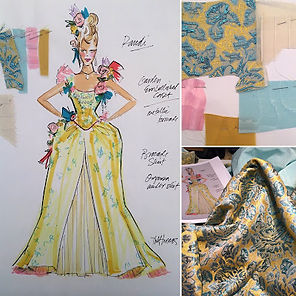New York City: Fashion Capital
My Process
I started this project with the question, “What makes New York City a fashion capital?” Throughout these last few months, I learned a great deal about urban history and the design process that helped me find my answer. I also did much of my own research as well as meeting with partners. I wanted to design a collection inspired by my own idea of New York as a city, which was influenced by this research.
My main takeaway for this project is that even though fashion has a reputation for being an elite concern, it is in some way accessible to everyone: whether it’s the mere ability to be creative, or the ability to buy clothes you like, or even just seeing different styles on the street. This was a cool idea to think about.
My next takeaway is that New York City is a hub for fashion not only due to the presence of so many different styles, but also because it is a immigration hub. Immigration sits at the center of New York City’s character and economy, and for a time made New York City a leader in manufacturing. In the 19th century, the availability of immigrant labor being predominantly Irish, Italian, and Jewish women provided the labor force that could meet the demand for affordable fashion in mass quantities.
Immigrant Women Sewing in the Garment District
A core part of my research came in the form of partner meetings. My first partner meeting was with Erica Lennard, a fashion photographer now a leader at Denis Colomb Lifestyle, a leading producer of exotic cashmere clothing and accessories. We had a conversation about how different designers find inspiration in the city, one being Isaac Mizrahi. We also discussed how much the fashion world in the city has changed since the 1900s, from improving manufacturing standards and the changing nature of immigration. One notorious example of the poor working conditions for immigrant women in the garment is the Triangle Shirtwaist Factory Fire of 1911.
Triangle Shirtwaist Factory Fire
Todd Thomas, a fashion designer here in New York City, was another important contributor for my project. Along with being a fashion designer, he is also an artist and worked for the Victoria's Secret fashion show for 11 years, and has partnered with numerous artists, musicians, and other designers. Our conversation was mainly about the differences of the fashion industry in the 1980s vs. now, with the main differences being the centralization of the community and social media. In some ways, the period that Todd described gave more independence from monopolies such as Vogue, but the same thing can be said today due to the popularity of social media and its impact for independent designers. Another way social media has had an impact is the way in which trends grow and circulate at an accelerated rate. An example of this is The Birkin. Take The Birkin, a classic representation of status, now being more visible to the masses through social media. Yes, it’s become more accessible from a visibility standpoint but in turn has developed a new allure of status that makes it even more exclusive. It’s contradicting because seeing the bag so frequently on social media makes it seem that this is an item many people have, but in reality is not. This also shows how social media has multiple narratives. One of the most significant changes in fashion by social media is the way trends rotate so fast.
Todd Thomas drawings
I created an immersive experience for my peers in CityGAP in order to dive more deeply into the relationship between fashion and the space of the city. The challenge was to design an outfit inspired by Bryant Park as a public space using non-traditional materials, no sewing, and a limited budget within a 24 hour period. It was insightful to see how people chose to find inspiration from the space and their reinterpretation of sustainable materials, which guided my final designs.
My biggest takeaway from this project is that fashion is more accessible today. In this case, accessibility refers to visibility, both on the streets of the city and social media, as well as the production of fashion from independent designers. Due to these trends, one can argue that fashion is more democratic today than it’s been in the past. This brings me back to my original question, why New York City? Factors such as access to visibility as well as social media are a big part of the answer to this question. These factors have decentralized the industry to make it more accessible.


